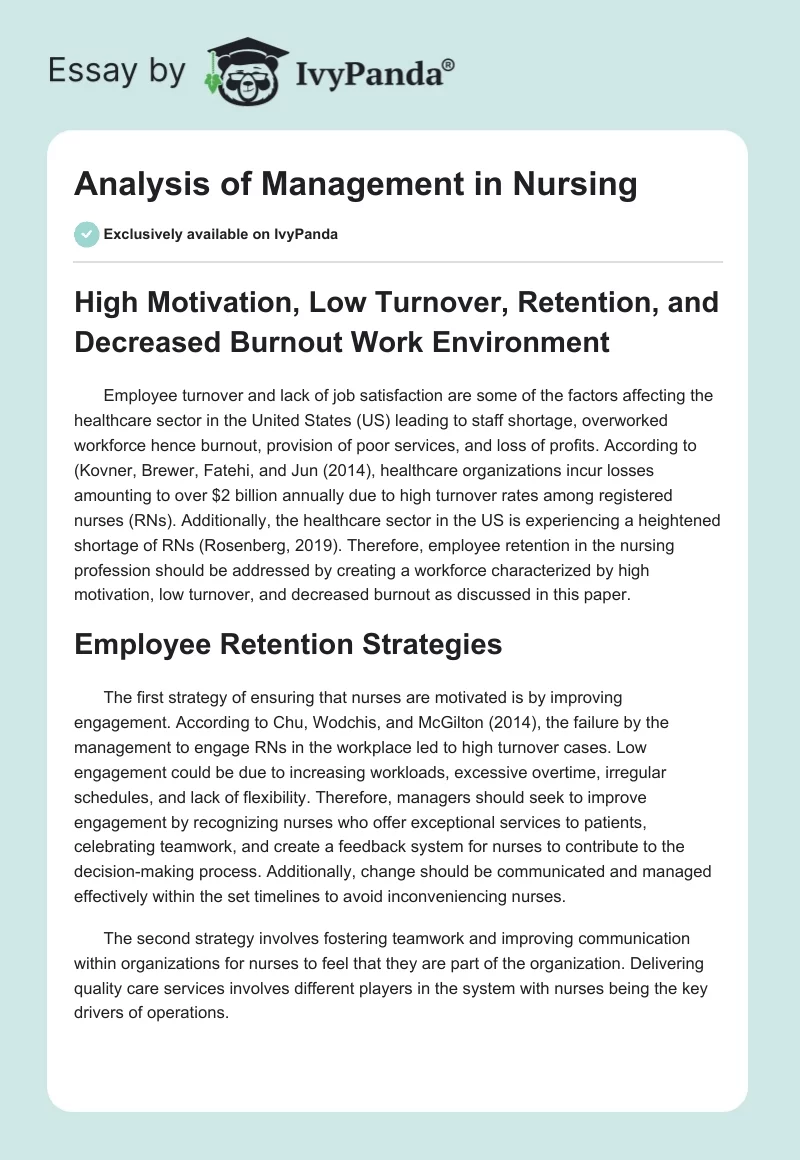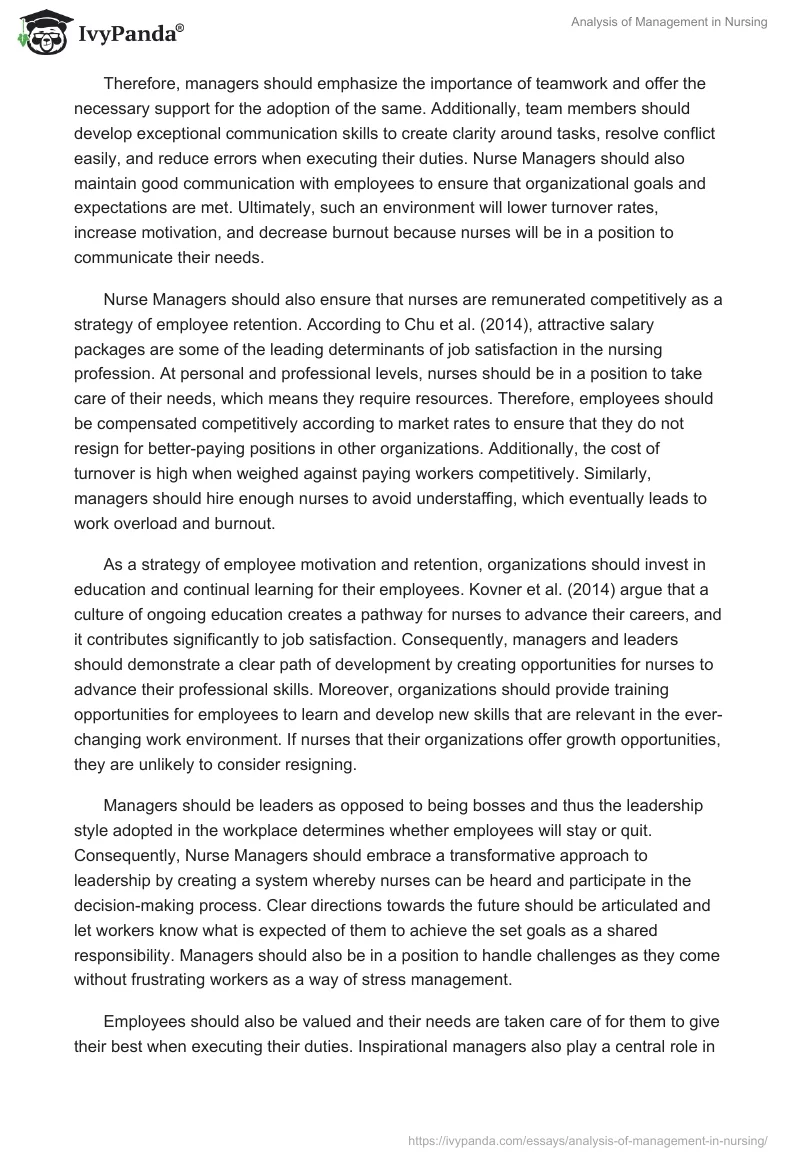High Motivation, Low Turnover, Retention, and Decreased Burnout Work Environment
Employee turnover and lack of job satisfaction are some of the factors affecting the healthcare sector in the United States (US) leading to staff shortage, overworked workforce hence burnout, provision of poor services, and loss of profits. According to (Kovner, Brewer, Fatehi, and Jun (2014), healthcare organizations incur losses amounting to over $2 billion annually due to high turnover rates among registered nurses (RNs). Additionally, the healthcare sector in the US is experiencing a heightened shortage of RNs (Rosenberg, 2019). Therefore, employee retention in the nursing profession should be addressed by creating a workforce characterized by high motivation, low turnover, and decreased burnout as discussed in this paper.
Employee Retention Strategies
The first strategy of ensuring that nurses are motivated is by improving engagement. According to Chu, Wodchis, and McGilton (2014), the failure by the management to engage RNs in the workplace led to high turnover cases. Low engagement could be due to increasing workloads, excessive overtime, irregular schedules, and lack of flexibility. Therefore, managers should seek to improve engagement by recognizing nurses who offer exceptional services to patients, celebrating teamwork, and create a feedback system for nurses to contribute to the decision-making process. Additionally, change should be communicated and managed effectively within the set timelines to avoid inconveniencing nurses.
The second strategy involves fostering teamwork and improving communication within organizations for nurses to feel that they are part of the organization. Delivering quality care services involves different players in the system with nurses being the key drivers of operations.
Therefore, managers should emphasize the importance of teamwork and offer the necessary support for the adoption of the same. Additionally, team members should develop exceptional communication skills to create clarity around tasks, resolve conflict easily, and reduce errors when executing their duties. Nurse Managers should also maintain good communication with employees to ensure that organizational goals and expectations are met. Ultimately, such an environment will lower turnover rates, increase motivation, and decrease burnout because nurses will be in a position to communicate their needs.
Nurse Managers should also ensure that nurses are remunerated competitively as a strategy of employee retention. According to Chu et al. (2014), attractive salary packages are some of the leading determinants of job satisfaction in the nursing profession. At personal and professional levels, nurses should be in a position to take care of their needs, which means they require resources. Therefore, employees should be compensated competitively according to market rates to ensure that they do not resign for better-paying positions in other organizations. Additionally, the cost of turnover is high when weighed against paying workers competitively. Similarly, managers should hire enough nurses to avoid understaffing, which eventually leads to work overload and burnout.
As a strategy of employee motivation and retention, organizations should invest in education and continual learning for their employees. Kovner et al. (2014) argue that a culture of ongoing education creates a pathway for nurses to advance their careers, and it contributes significantly to job satisfaction. Consequently, managers and leaders should demonstrate a clear path of development by creating opportunities for nurses to advance their professional skills. Moreover, organizations should provide training opportunities for employees to learn and develop new skills that are relevant in the ever-changing work environment. If nurses that their organizations offer growth opportunities, they are unlikely to consider resigning.
Managers should be leaders as opposed to being bosses and thus the leadership style adopted in the workplace determines whether employees will stay or quit. Consequently, Nurse Managers should embrace a transformative approach to leadership by creating a system whereby nurses can be heard and participate in the decision-making process. Clear directions towards the future should be articulated and let workers know what is expected of them to achieve the set goals as a shared responsibility. Managers should also be in a position to handle challenges as they come without frustrating workers as a way of stress management.
Employees should also be valued and their needs are taken care of for them to give their best when executing their duties. Inspirational managers also play a central role in motivating workers to remain committed to their work, which ultimately leads to job satisfaction and reduced burnout hence low turnover rates.
Finally, managers should create a brand that nurses can be proud to be associated with as a way of improving their personal reputation. In this age of activism, people want to offer solutions to the many problems ailing society and nurses should be allowed to take part in this important process. To achieve this goal, Nurse Managers could find a way of getting involved in charity work or programs that impact the local community.
Minimizing Subjectivity in Performance Appraisal Process
The process of performance appraisals has elicited mixed reactions in the workplace due to its subjective nature. Managers are tasked with the duty of rating their employees, and thus without clear guidelines, bias could infiltrate the process, thus causing friction between the management and workforce. This problem has been compounded by the fact that performance appraisal cannot be fully automated, and thus managers have to be involved in one way or another. However, the subjectivity could be minimized during the appraisal process to reduce cases of unfairness and bias as a way of improving employees’ job satisfaction and maintaining high motivation levels.
Ways to Minimize Subjectivity
The first step to minimizing subjectivity in the performance appraisal process is for managers to acknowledge the different forms of bias that promote this phenomenon. According to Nikpeyma, Abed-Saeedi, Azargash, and Alavi-Majd (2014), many appraising managers are not aware of the existence of biases because they operate at subconscious levels. For instance, managers could suffer from the halo effect, which is a form of bias that occurs when employees are good to their bosses thus creating favoritism. In such cases, managers would be unaware that they favor certain workers when the appraisal process starts, objectivity does not prevail, which leads to workplace injustice – a leading cause of nurse turnover (Chin et al., 2019).
Therefore, managers should be educated that biases are bound to exist hence the need to be aware of the same as a way of minimizing subjectivity. In essence, managers should be trained on ways of identifying bias, especially when approaching the appraisal season. In other words, being aware of biases and subjective nature of the appraisal process is a trainable skill, thus organizations should include such programs in their human resources management strategies.
Using objective ratings could also go a long way in minimizing subjectivity and bias in the performance appraisal process. This goal could be achieved by framing ratings in a way that encourages objectivity. The tone of the language used when creating ratings also plays an important role in this process. For example, using phrases, such as “follows orders” and “exceeds expectations” is subjective in nature. Instead, objective tone, such as “meets deadlines”, would allow managers to evaluate their answers and with critical thinking, biases could be minimized. The rating system should not give managers room for interpreting how employees are appraised.
Consequently, organizations are required to create objective, unbiased, and on point ratings. In such cases, the involved managers will approach all employees case-by-case based on the provided guidelines, which are not subject to personal opinions.
Additionally, performance appraisal should be done frequently to ensure that managers could recall events that are used in the process. When a lot of time passes between the occurrence of events and the appraisal exercise, recollecting facts could be impaired and the brain could settle for what it thinks is right at that particular time. In other words, people tend to forget facts as time lapses, and when they are required to remember them for a specific task, they may replace the real events with subjective thoughts. Therefore, appraisals should be conducted quarterly or bi-annually to ensure that managers recollect events easily for accurate ratings.
Alternatively, managers could develop tools, such as taking frequent notes on employees’ performance, to help in the appraisal process when it eventually happens. This way, appraisers will refer to their notes and write fair and accurate appraisals regardless of the time lapse between one exercise and another.
Finally, the appraisal process could be conducted by teams as opposed to one individual. As more appraisers are involved, the entire exercise becomes impartial and dispassionate hence the minimization of bias and subjectivity. Even if one or two individuals in the appraising group have favorites among the involved employees, their bias would be overshadowed by the objectivity of other appraisers thus ensuring fairness and improving accuracy. In other words, not all raters in any group will be driven by personal agenda and this aspect creates an attenuating effect for objectivity to dominate the appraisal process.
Conclusion
In summary, creating a work environment characterized by high motivation, low turnover, reduced burnout, and employee retention is a multifaceted venture that should be approached holistically. Managers should improve employee engagement, foster teamwork, offer competitive remuneration packages, invest in continued education and provide training opportunities, adopt a transformational leadership style, and establish a brand that employees are proud of, such as engaging in community work.
The impartiality and objectivity that a performance appraisal process is conducted with plays an important role in determining how employees function at the workplace. If workers feel that they have been rated unfairly through a biased process, they may lack motivation, which affects their productivity. Therefore, raters should ensure objectivity when conducting the exercise as a way of minimizing subjectivity.
One of the strategies that managers could use to achieve this goal includes being aware of the existence of personal biases that could be operating at the subconscious level. Objective ratings could also be used to prevent raters from using personal opinions when assessing employees’ performance. Moreover, the appraisal exercise should be carried out frequently to ensure that raters recall facts that determine the employees’ score. A team of raters could also be used to conduct the exercise instead of leaving it to individual managers.
References
Chu, C. H., Wodchis, W. P., & McGilton, K. S. (2014). Turnover of regulated nurses in long-term care facilities. Journal of Nursing Management, 22(5), 553-562. Web.
Kovner, C. T., Brewer, C. S., Fatehi, F., & Jun, J. (2014). What does nurse turnover rate mean and what is the rate? Policy, Politics, & Nursing Practice, 15(3), 64-71. Web.
Rosenberg, K. (2019). RN shortages negatively impact patient safety. American Journal of Nursing, 119(3), 51-53. Web.
Chin, W., Guo, Y.-L. L., Hung, Y.-J., Hsieh, Y.-T., Wang, L.-J., & Shiao, J. S.-C. (2019). Workplace justice and intention to leave the nursing profession. Nursing Ethics, 26(1), 307-319. Web.
Nikpeyma, N., Abed-Saeedi, Z., Azargash, E., & Alavi-Majd, H. (2014). Problems of clinical nurse performance appraisal system: A qualitative study. Asian Nursing Journal, 8(1), 15-22. Web.


